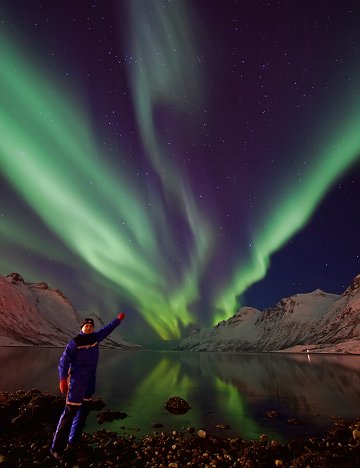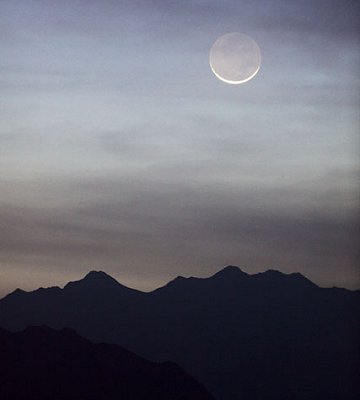SATELLITE FLYBYS APP: Turn your iPhone or iPod into a field-tested satellite tracker! Spaceweather.com presents the Satellite Flybys app. | | | CONJUNCTION CHALLENGE: Tonight, the two brightest planets are having a spectacular conjunction. Venus and Jupiter are only 1/2-degree apart. The only problem is, the event is happening deep inside the glow of the setting sun. Are you ready for the conjunction challenge? Go outside 15 to 30 minutes after sunset and look directly below the crescent Moon. Venus and Jupiter are down there. Find them if you can: sky map. AURORA BLAST: On Feb. 15th, an intense wave of Northern Lights swept across Scandinavia. "We had a fantastic blast of auroras here in Kvaløya, Norway," reports Helge Mortensen. "They were bright and very active. What a view!" He made this self-portrait using a Canon EOS 40D: 
The display got started when the sun's magnetic field near Earth tipped south. This opened a hole in Earth's magnetosphere. Solar wind poured in and fueled the auroras. The lights were so bright they reflected in water, cast shadows on snow, and descended as far south as Scotland and Northern Ireland. Browse the gallery for more views. UPDATED: February Northern Lights Gallery
[previous Februarys: 2009, 2008, 2007, 2006, 2004, 2003, 2002] EARTHSHINE ALERT: When the sun sets tonight, go outside and look at the Moon. It is an exquisite ~7% crescent. Amir H. Abolfath sends this preview from Kashan, Isfahan, Iran: 
"The Earthshine was particularly beautiful," says Abolfath. Earthshine is the light of our own planet shining down on the Moon's dark terrain. It makes a ghostly image of the full Moon inside the horns of the crescent. Five hundred years ago, Leonardo da Vinci was first to explain this phenomenon, and so it is sometimes called the "da Vinci glow." A crescent Moon with Earthshine is one of the prettiest sights in the heavens. Take a look! more images: from Adrian New of Helotes, Texas; from Sam Cole of Austin Texas; from Tamas Ladanyi of Veszprem, Hungary; from Christophe Stolz of Bern, Switzerland; from Tamás Ábrahám of Zsámbék, Hungary; from Redzuan of Penang, Malaysia
Solar Eclipse Photo Gallery
[eclipse alerts] [solar telescopes] | 
